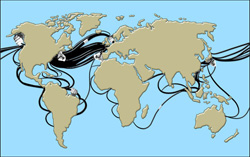Our Connected World
Many of us use computers and the Internet so frequently that we may take the interconnected world we live in for granted. But recent events have had some questioning the fragility of the system that makes communication across the globe possible.
The World Wide Web
The Internet has made the world more interconnected as society embraces the World Wide Web. The Internet population is know for its stability, and forecasts show that the worldwide online population will continue to escalate in the coming years. According to a JupiterResearch report, 1.1 billion people access the Web on a daily basis; by 2011, 22 percent of the Earth's population will use the Internet regularly.
How exactly is this connected world we live in possible?
Cabling the Seas
Believe it or not, the major portion of the world's communication is carried out by undersea cables. Submarine communications cables are cables that are laid beneath the sea to carry telecommunications between countries. Over 95 percent of transoceanic telecoms and data traffic are carried by undersea cables, according to the International Cable Protection Committee, an organization of submarine cable operators focused on cable security.

Why do we use submarine cables? These fiber optic cables transmit voice and data traffic with higher reliability, more security, and at cheaper rates than satellite systems. Especially for larger routes, such as trans-Atlantic and trans-Pacific routes, intercontinental submarine cables are known to be more cost affective.
We depend on collections of fiber optic cables that are less than 10 centimeters in diameter to connect our online world. While typically they are 69 millimeters in diameter and weigh 10 kilograms per meter, thinner and lighter cables are used for deeper water. The lines that tie the world together, according to reports, are a mere two centimeters thick where they lie on the ocean floor.
Breaks in the Web's Undersea World
It may seem like a fragile system, yet the framework is known for its resilience. While cables break far more often than we may realize (faults have been caused by fishing, ship travel, and even by shark bites), it takes a combination of factors for communications to be disrupted, reports say.
Such was the case, however, in early February 2008, when three undersea cables were cut, disrupting Internet access in South Asia and the Middle East. Undersea cable connections were disrupted off the northern coast of Egypt after segments of two international cables were cut. It was necessary for service providers to re-route traffic while repairs were made. Following that, a third undersea cable was reported broken between Dubai and Oman.
This was not the first time that outages have occurred, and it is unlikely to be the last. Communications were slowed down in Hong Kong and other parts of Asia for months following a 2006 earthquake that cut seven cables near Taiwan.
The events may serve as a call to action for professionals and governments to spend more resources on securing the backbone of our communication systems.
"Many areas of the world are connected by a relatively small number of Internet cables, and when several failures happen simultaneously, either by accident or deliberate attack, it seriously affects the ability to conduct business. These events should remind IT and business managers that they always need to prepare for catastrophes with service redundancy and business resumption plans," according to a statement on Gartner's website.


